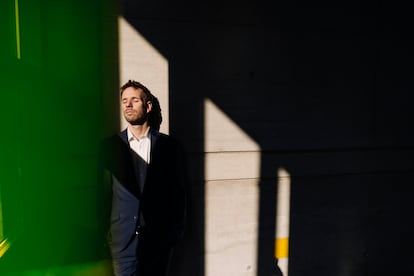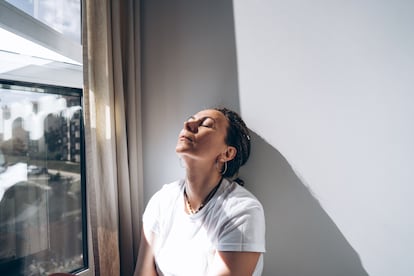

In the heart of the Italian Alps, right in a small turreted house next to Lake Ledro, a group of men and women laugh around a table while eating rolls, cake, polenta, cheese and, to accompany it, drinking cava or sparkling water and soft drinks. There are hugs, warm laughter, and that kind of joy from family or friends whose relationship has been forged over time. It is striking that most of them laugh like teenagers on a Saturday night even though they have white hair and this has been an arduous day, one more after many others. The bond, nature and exercise that they feel and experience is a type of protection against an evil that threatens to become a pandemic. And most of those here know it well. All of them come from Germany and the least of them has suffered at some point in their life, or has seen it in someone close to them, from exhaustion due to stress or burnout —also known as burnout syndrome—, which means not having the strength or motivation to move forward. In fact, in Germany, 61% of workers fear suffering from it, according to a report by the health insurance company Pronova, and a third of employees – 37% – complain of physical and mental exhaustion, according to a McKinsey study. Health Institute.
For example, Jean (not his real name), white beard, red polo shirt, brown eyes, stirs a pepper stew in the kitchen and thinks of one of his children when he hears about burnout. His first-born son is the head of a multinational, and in January and February he was in a clinic to learn new habits due to having suffered physical and mental exhaustion. Reason? Work overload, perhaps having had to fire many people without agreeing and aware that some would have serious difficulties in overcoming it. “What can I do as a father? How can I help my son?” the man asks himself as he shakes his head and looks down.
Soon after, from the kitchen, Peter, president of a local climbing club—the Deutscher Alpenverein Sektion Karlsruhe—and a retired executive who has investigated the burnout in depth in recent years concerned with finding tools to confront and prevent the plague, he reflects on the depth of this problem. “Millions of euros are invested in Germany in clinics, pills, therapy and treatments, but very little in preventing it. We know what it is and how to define it, but we don’t know how to cure it. We know that there are many conditions, such as the fact that since the pandemic teleworking has skyrocketed; We do know that,” he says while observing the most senior members—women and men—of the climbing club he presides, who laugh around some rolls seasoned with tomato and parsley. “It is very important for managers to avoid causing stress. One in ten adults lives alone, they work a lot and at the end of the day they are alone; some have at most only one contact with another person in the entire week. What to do?”, he reflects, takes a breath and answers himself. “He burnout It is an x-ray of society. I think each person has to do what they can to fight the battle, and avoid it. “I do what I can in my small circle,” he adds.
Sandra G., 47 years old, social worker by vocation and victim of burnouthas a partner who adores her and takes care of her garden whenever she can. She presides over a gardeners’ club, plays the cello, sings and is always there for her many friends. Before experiencing the collapse, he had an intensive schedule that forced him to not sleep more than a day and he never stopped thinking about those in his care—refugees and girls suffering from anorexia—with whom he worked. One day he lost his hope, realized that he had no strength and had a slight problem with a colleague. Then he collapsed. After months had passed and the long waiting list had been overcome, Sandra was admitted by medical prescription to one of the many—hundreds—free clinics dedicated exclusively to burnout that there is in Germany. “At the center we did individual and group therapy, mindfulnessexercise… Being with people who have gone through the same thing as me has been the most important thing,” he explains.

“The first thing is to understand where everything comes from,” considers Sandra. “Imagine a child who has to take care of his siblings, the father is not there, and no one ever praises what he does. The child does not feel anything, he endures everything, but he does not feel. More is always asked for. When he is an adult he carries more and more,” she explains, visibly excited. “I have learned that I have to pay attention to the muscles that warn me of stress, and exercise. He burnout It can last for years, now I know that when it happens you don’t have to abandon work and leave everything. Also that people like me endure without setting limits until something breaks the camel’s back and then it spills,” he adds.
In Spain, for María, as she explains, the last straw was the arrival of a toxic colleague at work who she did not know how to deal with. She had been disillusioned and powerless for some time. He learned that he was on the verge of mental and physical collapse from the tests, and his doctor decreed that he must learn to relax; It would get worse if he continued like this, but his burden of responsibilities continues. For years she has focused on work because she loves what she does, but she is responsible for the full-day care of her very elderly mother. Since the arrival of the pandemic, he worked at home, and for years he has barely gone out for fear of contagion. Now you have all the symptoms of burnoutbut it is evident that he has not been able to change toxic habits. Perhaps it is because the importance of the problem has not yet penetrated public opinion, although professional burnout is, according to the World Health Organization, a disease.
The boiled frog
In Spain, professional burnout in one form or another affected 43% of the population in 2022, according to the Labor Market Guide. However, it is not the same severity in all cases. “There are many levels of burnout. There is also a descriptive image to explain it,” says Esther Pérez, creator of the psychology office in Zaragoza that bears her name from the other side of the phone. “Imagine a frog that falls into a pot of warm water. The frog feels good there. You raise the heat little by little, and the frog is still fine. But he can no longer flee when the water boils and he dies. People with burnout They can be like that frog. The pressure is more than they can bear, but they believe that the problem is theirs without realizing that the pressure is unbearable,” adds the specialist, who assures that the cases she treats have increased after the pandemic. “Many people who suffer from it also have family responsibilities,” adds the psychologist, who calls for taking into account that burnout It is real and can be an opportunity to change your life if you act in time.
Gustavo Diez, founder and director of Nirakara—an institute specialized in mental health research and training—has been making training proposals for years to improve the quality of life, and also to avoid burnout and its causes. “The brain seeks to keep us alive and does so by promoting balance. For example, an exhausted elite athlete will have post-competition depression and lack of motivation because the brain generates behaviors and emotions to avoid tasks that put us at risk. (…) There are different cases. There are people who need therapy because their childhood was difficult, the reason for others is excess professional pressure,” adds Diez, who, since Nirakara, has researched the brain together with laboratories at universities such as the Complutense. “To avoid the burnout It is essential to know ourselves, evaluate what we want and our values. Knowing that this is our lifetime, and that life ends,” he explains.

For Emiliano Bruner, biologist researching brain evolution at the National Center for Research on Human Evolution (CENIEH) and collaborator at the Center for Research in Neurological Diseases, the most important thing is to develop attention and get out of automatic life; that is the protection against collapse and the way to avoid problems. “The brain is a muscle that is trained and attention is a practice that is learned. Most people live automatically and that can lead to collapse,” says Bruner, for whom the key to preventing ailments such as burnout It is training the brain in the same way as a muscle. “To educate attention the first thing is to return to the body. Paying attention to breathing and the senses is a way to engage attention,” he explains. That led him to practice mindfulness: “It’s about gymnastics for the brain; This leads you to get out of the automatic life, to observe and make decisions that avoid problems. Fifteen minutes of daily meditation changes your life,” he details. Doing yoga or meditating does not guarantee avoiding exhaustion, although it helps if you can bring your attention to the body. For Bruner, the definitive thing is to act: “When you are attentive and know what can happen to you if you continue on the same path; and you know what you want. What we have to do is make decisions and act, although that is the most difficult thing,” explains the scientist.